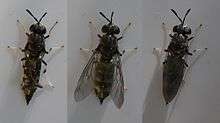Hermetia illucens
| Hermetia illucens | |
|---|---|
 | |
 | |
| Scientific classification | |
| Kingdom: | Animalia |
| Phylum: | Arthropoda |
| Class: | Insecta |
| Order: | Diptera |
| Suborder: | Brachycera |
| Infraorder: | Tabanomorpha |
| Superfamily: | Stratiomyoidea |
| Family: | Stratiomyidae |
| Subfamily: | Hermetiinae |
| Genus: | Hermetia |
| Species: | H. illucens |
| Binomial name | |
| Hermetia illucens Linnaeus | |
Hermetia illucens, the black soldier fly, is a common and widespread fly of the family Stratiomyidae. Neither the larvae nor adults are considered pests or vectors. Instead, black soldier fly larvae play a similar role to that of redworms as essential decomposers in breaking down organic substrates and returning nutrients to the soil/environment.
Black soldier fly larvae (BSFL), are an excellent source of sustainable protein for aqua culture/ animal feed, pet and human nutrition. As the larvae have voracious appetites they can be used for composting household food scraps and agricultural waste products.


Life cycle
Black soldier fly eggs take approximately four days to hatch and are typically deposited in crevices or on surfaces above or adjacent to decaying matter such as manure or compost.[1] The larvae range in size from 1⁄8–3⁄4 inch (3–19 mm). Although they can be stored at room temperature for several weeks, their longest shelf life is achieved at 50–60 °F (10–16 °C).
The adult fly, which measures about 16 mm (5/8 inch),[2] has a life span of 5 to 8 days. It is a mimic, very close in size, color, and appearance to the organ pipe mud dauber wasp and its relatives. The mimicry of this particular kind of wasp is especially enhanced in that the fly's antennae are elongated and wasp-like, the fly's hind tarsi are pale, as are the wasp's, and the fly has two small transparent "windows" in the basal abdominal segments that make the fly appear to have a narrow "wasp waist". The adult soldier fly has no functioning mouthparts; it spends its time searching for mates and reproducing.

Uses in composting or as food for animals
Black soldier fly larvae (BSFL) are used to compost and sanitize wastes, and/or convert the wastes into animal feed. The harvested pupae and prepupae are eaten by poultry, fish, pigs, turtles; even dogs.[3] The wastes include fresh manure, food wastes of both animal and vegetable origin.
Grub composting bins use self-harvesting
When the larvae have completed their larval development through six instars, they enter a stage called the "prepupa" wherein they cease to eat, they empty their guts, their mouth parts change to an appendage that aids climbing, and they seek a dry, sheltered area to pupate.[4] This prepupal migration instinct is used by grub composting bins to self-harvest the mature larvae. These containers have ramps or holes on the sides to allow the prepupae to climb out of the composter and drop into a collection area.
Benefits
Larvae are beneficial in the following ways:
- They prevent houseflies and blowflies from laying eggs in the material inhabited by black soldier fly larvae.[5]
- They are usually not a pest.
- They are not attracted to human habitation or foods.[5] As a detritivore and coprovore, the egg-bearing females are attracted to rotting food or manure.
- Black soldier flies do not fly around as much as houseflies. They are very easy to catch and relocate when they get inside a house, as they do not avoid being picked up, they are sanitary, and they do not bite or sting. Their only defense seems to be hiding. When using a wet grub bin that will collect or kill all the pupae, the black soldier fly population is easy to reduce by killing the pupae/prepupae in the collection container, before they become flies. They may be killed by freezing, drying, manually feeding to domestic animals, putting the collection container in a chicken coop for automatic feeding, or feeding to wild birds with a mouse/pest-proof feeder.[6]
- Significant reductions of E. coli 0157:H7 and Salmonella enterica were measured in hen manure.[4]
- They quickly reclaim would-be pollutants: Nine stinky organic chemicals were greatly reduced or eliminated from manure in 24 hours.[4]
- They quickly reduce the volume and weight of would-be waste: The larval colony breaks apart its food, churns it, and creates heat, increasing compost evaporation. Significant amounts are also converted to carbon dioxide respired by the grubs and symbiotic/mutualistic microorganisms.
Establishing and building larval colonies
The main difficulty is obtaining black soldier fly larvae or eggs to start or replenish the colony. This is usually done by enticing the soldier flies to lay eggs in small holes over the grub bin. Adult flies lay clusters of eggs in the edges of corrugated cardboard or corrugated plastic. In some regions, it is possible to start or maintain adequate larvae colonies from native soldier flies; however, pest species such as houseflies and blowflies are also drawn to many of the foods used to attract soldier flies (such as fermented chicken feed).
In tropical or subtropical climates, they might breed year-round, but in other climates, a greenhouse may be needed to obtain eggs in the cooler periods. The grubs are quite hardy and can handle more acidic conditions and higher temperatures than redworms. Larvae can survive cold winters, particularly with large numbers of grubs, insulation, or compost heat (generated by the microorganisms in the grub bin or compost pile). Heat stimulates the grubs to crawl off, pupate, and hatch, and a great deal of light and heat seem to be required for breeding. Many small-scale grub farmers build their larval colonies from eggs deposited by wild soldier flies.
Requirements for captive-breeding chambers
Captive breeding can also keep pest flies away if done carefully.
Space and shape
Newly emerged soldier flies mate in flight.[7]
“Tingle et al (1975)… reported that mating and oviposition were observed “often” in a 3 × 6.1 × 1.8 m cage held outdoors. In addition, mating was observed in a 0.76 × 1.14 × 1.37 m cage held outdoors, but not when held in the greenhouse.”[7]
“No mating or egg collections occurred in two small cages (53×91×53 cm) and (38×46×38 cm)”[7]
More recently, captive breeding has been observed in a cylindrical chamber measuring 46 cm (18 in) diameter by 56 cm (22 in) tall for 99 litres (3.5 cubic feet). "Mating under artificial light did not occur but did succeed with natural sunlight." [8]
German scientists have successfully bred soldier flies in a space as small as 10 liters.[9][10]
Heat
“Adults typically mated and oviposited at temperatures of 24 °C (75 °F) up to 40 °C (104 °F) or more. Booth and Sheppard (1984) reported that 99.6% of oviposition in the field occurred at 27.5–37.5 °C (81.5–99.5 °F)”[7]
Light
“Minimum light intensity for mating is 63 μ mol m2s -1 with most mating occurring at over 200 μ mol m2s -1 (J.K.T. and D.C.S., unpublished data).”[7]
Humidity
“Relative humidities of 30–90% supported mating and oviposition”[7]
Human food
Black soldier fly larvae are edible to humans. The larvae are highly efficient in converting proteins, containing up to 42% of protein, and a lot of calcium and amino acids. In 432 hours, 1 gram of black soldier fly eggs turns into 2.4 kilograms of protein. They thus can be a source of protein for human consumption.
In 2013, Austrian designer Katharina Unger invented a table-top insect breeding farm called "Farm 432" in which people can produce edible fly larvae at home. It is a multichambered plastic machine that looks like a kitchen appliance. According to Unger: “Farm 432 enables people to turn against the dysfunctional system of current meat production by growing their own protein source." About 500 g of larvae or two meals can be produced in a week by the machine.
The taste of the larvae is said to be very distinctive. Unger: "When you cook them, they smell a bit like cooked potatoes. The consistency is a bit harder on the outside and like soft meat on the inside. The taste is nutty and a bit meaty."[11]
Black soldier fly larvae and redworms
Worm farmers often get larvae in their worm bins. Larvae are best at quickly converting "high-nutrient" waste into animal feed.[12] Redworms are better at converting high-cellulose materials (paper, cardboard, leaves, plant materials except wood) into an excellent soil amendment.
Redworms thrive on the residue produced by the fly larvae, but larvae leachate ("tea") contains enzymes and tends to be too acidic for worms. The activity of larvae can keep temperatures around a 100°F, while redworms require cooler temperatures. Most attempts to raise large numbers of larvae with redworms in the same container, at the same time, are unsuccessful. Worms have been able to survive in/under grub bins when the bottom is the ground. Redworms can live in grub bins when a large number of larvae are not present. Worms can be added if the larval population gets low (in the cold season) and worms can be raised in grub bins while awaiting eggs from wild black soldier flies.
As a feeder species, BSFL are not known to be intermediate hosts of parasitic worms that infect poultry, while redworms are host to many.[13]
Possible Natural Enemies
In West Africa, Dirhinus giffardii has been found to be a parasitoid of H. illucens pupae and have a negative impact on egg production. It has been found to reduce stocks by up to 72%. The parasite is carried by the wasps and precautions should be taken to protect the larvae from exposure to these wasps. [14]
Names and trademarks
A generic term for grubs of Hermetia illucens is black soldier fly larvae, abbreviated as "BSFL". Black soldier fly larvae were developed as a feeder insect for exotic pets by D. Craig Sheppard. Dr. Sheppard named the larvae Phoenix Worms and began marketing them as pet food. In 2006, Phoenix Worms became the first feeder insect to be granted a U.S. registered trademark. Other companies also market black soldier fly larvae and use their own brand names such as "Soldier Grubs," "Reptiworms" ,"Calciworms, and "BIOgrubs." In Australia Black soldier Fly Larvae are marketed as live feeder insects under the trade marked brand name "Beardie Grubs" at selected pet stores.
References
- ↑ Hermetia illucens (University of Florida)
- ↑ Savonen, Carol. "Big maggots in your compost? They're soldier fly larvae". OSU Extension Service - Gardening. Oregon State University.
- ↑ TROVET Hypoallergenic (Insect) | IPD (TROVET Netherlands)
- 1 2 3 "Research Summary: Black Soldier Fly Prepupae - A Compelling Alternative to Fish Meal and Fish Oil". February 14, 2011.
- 1 2 "Black Soldier Fly: Compiled Research On Best Cultivation Practices". Research Resources. 9 July 2008.
- ↑ Feeding Grubs to Birds EXPERIMENT
- 1 2 3 4 5 6 "BSD Prepares to Test Soldier Fly Mating Facility (follow up comment)".
- ↑ Black Soldier Fly Indoor Breeding Inclosure
- ↑ Breeding BSF in captivity / Re: not easy
- ↑ (translation of) Zucht der schwarzen Soldatenfliege (Hermetia illucens)
- ↑ Katharina Unger, “Farm 432: Insect Breeding” in Dezeen Magazine, 25.3.2013, at http://www.dezeen.com/2013/07/25/farm-432-insect-breeding-kitchen-appliance-by-katharina-unger/
- ↑ Modern animal feed eco-friendly solutions
- ↑ "TABLE 05: Common Helminths of Poultry". The Merck Veterinary Manual / Poultry / Helminthiasis. Retrieved April 20, 2008.
- ↑ Devic, Emilie; Maquart, Pierre-Olivier (2015-12-09). "Dirhinus giffardii (Hymenoptera: Chalcididae), parasitoid affecting Black Soldier Fly production systems in West Africa". Entomologia. 3 (1). ISSN 2281-9584.
External links
| Wikimedia Commons has media related to Hermetia illucens. |
- Black Soldier Fly Blog
- Black Soldier Fly Farming
- The GrubCycle Solution
- Forging a New Food Chain
- Report for Mike Williams (2005)
- Bioconversion of Food Waste : Black Soldier fly
- 'Grubby' Research Promises Environmental, Economic Benefits
- Black soldier fly on the UF / IFAS Featured Creatures website

